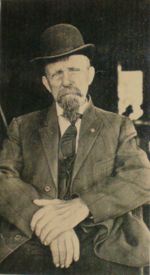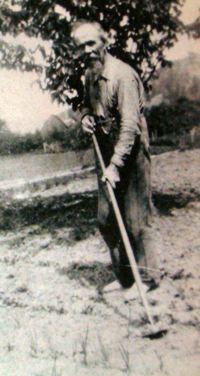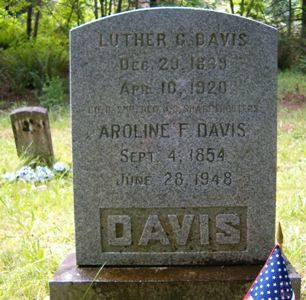
Luther Grover Davis
Born: December 29, 1840 near Cherryfield, Maine
2nd United States Sharpshooters, Company D Enlisted: November 2, 1861 Promoted to Corporal: November 12, 1862 Promoted to Sergeant: April, 18, 1864 Discharged: February 20, 1865
Died: April 10, 1920 in Drain, Oregon
This biography was written by Clifford Galen LaMear, Great Grandson of Sgt. Davis and provided for use on this site by M.A. Douglas, Great Great Grandson of Sgt. Davis.
Thank You
Early Life
Luther Grover "L.G." Davis was born December 29, 1840, near Cherryfield, Maine. Cherryfield was founded in 1757 by L.G.'s grandfather, Ichabod Willey, and Samuel Colson. Ichabod, who was a millwright, built the first sawmill on the Narragaugus River.
Cherryfield is located at the head of tidewater on the Narragaugus. The river was dammed for early sawmills and shipbuilding. In the 1860s, six water mills powered a grist mill; planing mill, sash, door, and blind factory; a foundry and machine shop; and a gang saw, edge and lath mill. Other manufacturers were ships, carriages, harnesses, shoes, furniture and clothing. Cherryfield also had a silver mine.
During its peak in the 19th century, Cherryfield's population was almost 1,700. The population declined to 300 people. Many reasons account for the shrinkage: the forests were logged; the soil was rocky and unproductive; fishing and shipbuilding dwindled; and many small industries left Cherryfield -- and much of New England -- to relocate in the southern and western states.
L.G. was the sixth of nine children. His ancestors were Scotch [Scottish], Scotch-Irish, and English. Both his Leighton and Pinkham ancestors had originally settled in Dover, New Hampshire, during the 1630s. A map from History of Dover, New Hampshire (1923) shows the locations of the mid-1600s homes of ancestors Elder Hatevil Nutter, Thomas Leighton, and Richard Pinkham. L.G.'s Davis and Willey ancestors also moved from New Hampshire to Maine for the land that was made available in the lottery townships.
The Leighton-Pinkham history is chronicled in two other Interesting books: Richard Pinkham of Old Dover and His Descendants (1908) and A Leighton Genealogy (1989). The three books include stories of Indian troubles, of Elder Nutter physically persecuting female Quaker missionaries, and of his granddaughter spending time in the stocks for "entertaining" Quakers.
Family tradition says that a dying black man cursed a Davis pirate ancestor: "All brown-eyed Davises will bleed to death." My research had not yet confirmed this story.
L.G.'s family lived north of Cherryfield on Willey Hill, probably near the Davis Family Cemetery. The cemetery is about one mile north of town on the west side of Highway 193. The census records of 1830 through 1870 show that many Willey grandparents, uncles, aunts, and cousins lived on Willey Hill and that other Leighton and Pinkham relatives lived in Cherryfield and other nearby towns.
Civil War Life
By November 1861, when the Civil War had begun in earnest, L.G. was twenty-one years old. He was five foot ten inches tall and had auburn hair, hazel eyes, and a light complexion (dark in some accounts). With his backwoods shooting skills, L.G. was an ideal candidate for an unusual unit in the Union Army.
Colonel Hiram Berdan was one of the more colorful officers in the Union Army. He was both a mechanical engineer who designed firearms and the acknowledged top rifle shot in the country. He had the idea of recruiting exceptional marksmen to form regiments of Sharpshooters as skirmishers-snipers. He sent recruiters throughout the north seeking the best marksmen. L.G. qualified by shooting 200 yards to a target where 10 bullets had to be within an average 5-inch ring. On November 2, 1861, L.G. enlisted into Company D of the Second U.S. Sharpshooters Regiment (U.S.S.S.). Company D was composed entirely of Maine volunteers.
Berdan had promised the recuits extra pay and the finest target rifles, long-barreled .52 Sharps wth telescopic sights. The extra pay never did materialize and the Army Ordinance Department refused to purchase the special rifles until Berdan persuaded Lincoln to intercede. When L.G.'s 2nd Regiment arrived in Washington, they were told by 1st Regiment soldiers that U.S.S.S. stands for "Unfortunate Soldiers Sadly Sold." The soldiers hung an effigy of Berdan and blew it to bits with gunpowder. Terrified, the Colonel had his headquarters guarded by 1st Regiment Company A, composed of Swiss- and German-born soldiers.
The Sharpshooters were pleased with their unusual uniforms. Their coats, blouses, and trousers were green; their caps were either green or grey and sported ostrich plumes; their buttons were of hard rubber to eliminate flash. The men appreciated the camouflage. Confederate soldiers called them "snakes in the grass."
The 2nd Regiment's first skirmish was with the Confederate Cavalry in April 1862. In May and June, the Sharps rifles finally arrived.
As skirmishers, Sharpshooters were sent in advance of the main body of troops to scout Confederate locations. Typically, more casualties occurred during these minor scouting expeditions than during major engagements. In the latter, Sharpshooters targeted Confederate officers from the relative safety of long distances.
On August 30, 1862, at the Second Battle of Bull Run, the 2nd Regiment was pinned down at Railroad Cut Ditch and had many casualties. This was part of a general Union rout.
A few weeks later, at the Battle of Antietam in Maryland, the 2nd Regiment helped chase Confederate rebels off South Mountain. Of all the units, the 2nd did the most damage to the rebels. One of the 2nd Regiment's targets, the 7th South Carolina, lost 140 out of 268 men. The 2nd itself had twenty-five percent casualties.
On December 13, back in Virginia, the 2nd saw limited action at the Battle of Fredericksburg. Shortly thereafter, Berdan was court marshaled: during serious danger, he always seemed to disappear. The charges were dismissed. On November 12, 1862, L.G. was promoted to Corporal to "fill a vacancy." From April 7 through June of 1863, he was detailed to daily duty in the Construction Corps of Whipples Division.
In July, at the Battle of Gettysburg, the 2nd Regiment played a key role in saving the essential Little Roundtop for the Union. The 2nd sniped at Longstreet's advance, then fell back to the rocky place between Little and Bid Round Tops, just west of Devil's Den.
From behind a stone fence, the 2nd focused their fire on the 4th Texas Infantry. They chose their targets carefully. The Texans' Colonel and Lieutenant Colonel both fell wounded. Another Texas officer, Lieutenant Joe Smith, had stopped on that hot afternoon to dip his handkerchief in Plum Run Creek and to wind it around his head. The handkerchief proved to be an irresistible target for the Sharpshooters. When Smith's comrades removed the blood-soaked handkerchief from his head, they counted eleven bullet holes in it.
As the second moved to the side of Little Round Top, they encountered the 15th Alabama on its way to its historic fight with the 20th Maine under Colonel Joshua Chamerlain. The sharpshooters engaged the 15th Alabama and delayed them until they were too late to take Little Round Top and attack the Union's exposed left flank.
Ted Davis said that his father was wounded on the third day of the Battle of Gettysburg. This is not confirmed by L.G.'s military record.
After Gettysburg, Berdan had experienced enough danger and took his discharge from the Army. On December 21, 1863, L.G. reenlisted to his same unit. On April 16, 1864, he was promoted to sergeant.
During the campaigns of spring and summer 1864, the marksmen served admirably as both skirmishers and as specialists picked for specific details. At the May 1864 Battle of the Wilderness, the 2nd fought intensely -- one member fired 150 rounds -- and the regiment suffered many casualties. The 2nd fought on through the Battle of Spotsylvania and the siege of Petersburg.
On February 20, 1865, L.G.'s regiment was "discontinued." On February 25, Sergeant L.G. Davis was discharged as "supernumerary."
Several historians have written that the Sharpshooters killed more Confederates than did any other regiment in the Union Army. By the end of the war, the 1st and 2nd regiments together had experienced forty percent casualties. The 2nd Regiment lost eight officers and 123 enlisted men to disease.
L.G.'s medical records indicate his good fortune:
Contusion - June 10 to 27, 1862 Diarrhea - September 1862 Fever - December 28 to 30, 1863 Debility - February 5-21, 1865

Post-War Life
Back home in Maine, L.G. found that the farm and woods held little opportunity for a young man. During the 1860s, many men from New England went to Minnesota to work in lumber; the Minnesotans called them "Bangor Tigers." In 1867, our Bangor Tiger followed the call to "Go west, young man!" L.G.'s brother, Eli, went to Minnesota about the same time; Eli's youngest child was born there in 1870.
During the same year, L.G. worked as a lumberman. He lived in a Minneapolis boarding house run by Sarah Willey with her seven children, all born in Maine. Sarah was probably a distant relative on the Ichabod Willey side of the family.
L.G. met Aroline Flavilla Hamlet among the Maine expatriates, and they were married by the Reverend H.M. Stewart on August 5, 1872. Probably in the 1860s, Aroline and her family had moved from Brownville in central Maine. Her mother's ancestry is well-documented in History of the Family of Benjamin Snow (1907).
L.G. and Aroline lived in Minneapolis for the first few years of their marriage, then moved about 40 miles northwest to Elk River, where they reaised their family. Their first child was born in Minneapolis, their other children in Elk River.
Fred Leroy Davis was born in Minneapolis on March 25, 1874 and died there on July 20, 1874.
Willimetta "Maude" Davis was born March 19, 1875. She graduated from Elk River High School and from the State Normal School at St. Cloud in teaching.
Dewitt Clinton "Tip" Davis was born June 17, 1878, and graduated from Elk River High School.
Flora Gertrude "Gert" Davis was born July 28, 1881, and graduated from the State Normal School.
Mildred Izetta "Molly" David was born June 3, 1884, and graduated from the State Normal School.
Thadeus Eugene "Ted" Davis was born June 20, 1889.
Hellin Lucell Davis was born November 2, 1894, and died November 11, 1894.
Of the five children who reached adulthood, only Molly Davis kept her pronounced Maine accent through Normal School and the rest of her life in Oregon.
In 1885, L.G.'s family was surrounded by relatives. Aroline's sister, Helen Amanda Hamlet Heath, and her family lived next door. L.G.'s sister-in-law, Mahala Colson Davis (wife of Eli), and her two children lived nearby. Aroline's uncle, Benjamin Flavel Snow, lived in Big Lake. Many Hamlet relatives lived across the Mississippi River in Monticello. Other probable relatives living in the same county include seven Heath families from Maine.
In the late 1850s, a number of Maine Hamlets and Snows moved to the Elk River area. Later, many of these Hamlets, Snows, and Davises relocated to Oregon and Washington.
In 1892, at the age of 51, L.G. applied for and obtained a pension for his military service. His application cited rheumatism, general debility, and an injury to his right hand.
It is not clear which member of L.G.'s family started the move to Oregon, but Maude was one of the first. She taught in the Pendleton area, perhaps on an Indian reservation. On June 24, 1914, she married Hiram Lorette "Manny" Cowles in Minneapolis.
Family tradition says that, in 1903, Tip Davis rode the rails to Drain, Oregon, to find work logging. He and Minnie Myrtle Moore were married in Drain on April 6, 1904.
L.G. Davis arrived in Drain in 1907 when he was sixty-seven years old. He found work as a carpenter building a new sawmill at Leona. He walked six miles each way to what was probably a ten or more hour strenuous workday.
L.G.'s children who survived infancy settled in Drain and lived most of their remaining years there. L.G. continued to work as a carpenter. He built a number of homes, including his own.
The 1910 census record states that seventy-year-old L.G. had worked as a carpenter during the previous year with no months of unemployment. It also states that two relatives lived with L.G. and Aroline: their daughter, Gert, who taught at the public school, and Aroline's first cousin-once-removed, Guy Hamlet, who worked as a barber in a rented shop in Drain. Back in Minnesota, Guy had lived across the Mississippi River from L.G. and Aroline. Two of his grandparents were brother and sister to Aroline's parents.
Gert married Earnest "Ernie" Whipple on July 2, 1911. She died on October 2, 1917, leaving two young children, Jim and Dorothy.
The 1920 census record states that five relatives lived with L.G. and Aroline: their daughter Maude and her husband, Manny, and their son-in-law Ernie and his children, Jim and Dorothy. Maude and Manny moved to their own farm the following year. Ernie and his children continued to live with L.G. and Aroline until Ernie remarried.
A high point in L.G.'s later life was the fiftieth reunion of the veterans of the Battle of Gettysburg. After a big send-off in Portland by Governor West and other officials, L.G. traveled by train to Gettysburg. On June 13, 1913, L.G. wrote a letter to "Allie" (Aroline) describing his experiences at the reunion:
Gettysburg June 30 (1913)
My Dear Allie,
We got hear last night at 8'o'clock. Our tent is about two hundred yards in front of the place occupied by Lee, right in the fight.
I went this morning to scene of the conflict on the third. I did think of going further down on the left to the place where we fought on the 2nd but gave it up as it was too far for me to walk. Will go later.
The battlefield looks to me much the same as it did in '63 except they have built some houses on the neutral ground between the two contending lines and have beautified the land that both lines occupied by building splendid roads the entire length of both lines and erecting markers on the ground where the different commanders fought. The union states have erected some splendid monuments to the memory of those dead, and the Gen. Government has laid out a parade and erected monuments in honor of those dead. It is the grandest place in the world I think.
The town of Gettysburg has grown from a sleepy little town of perhaps two hundred to city of 4 thousand and have erected splendid buildings with wide and well paved streets and assigned to the different states. It covers 40 acres. The most of the Grand Army men stand the heat (which is intense) very well I think considering their age, still (I hear) of a number of deaths but one man from Oregon has gone to the hospital and he ought not to have come.
General Sickles who commanded our Corp. and lost his leg is here. He is 98 years old and did as much to win the field in '63 as any one man. He is living in his tent on the spot where he lost his leg.
I will try to write you every day and if I tell too much will run out. So goodbye until tomorrow.
Luke
He returned to Drain with small commemorative goblets of clear and ruby glass for each of his five grandchildren: Bernard Davis, Vida Davis, Lois Brands, Donald Davis, and Jim Whipple.
Anna Belle Davis LaMear recalled that a uniform with sword was stored in L.G.'s spare closet; it was probably his Knights of Pythias uniform. The encyclopedia describes Knights of Pythias as "a fraternal organization established to promote friendship, charity, and benevolence. It was founded on February 19, 1864, by Justus H. Rathbone in an effort to heal the hatreds caused by the Civil War."
L.G.'s children enjoyed telling of their father's nightly habit of saying to Aroline, "Come, come, let's go to bed," even if they had company.

Luther Gover Davis died in Drain on April 10, 1920. His death certificate states that the cause of his death was "acute dilation of the stomach" and contributing "chronic gastritis for ten years." He was buried in the North Drain Cemetary on April 12, 1920. L.G.'s gravestone reads:
Luther G. Davis
Dec. 29, 1839 - April 10, 1920 Co. D, 2nd Reg. U.S. Sharpshooter
Aroline F. Davis was buried at his side in 1948. Her net estate consisted of the home built by L.G., which sold for $5,000.00, and $188.48 in cash.
L.G. and Aroline have more than 88 total descendants [at the time this was written]. At least 67 of these descendents [at the time this was written] resident in Oregon, Washington, California, and Montana.
In addition to the photographs, the letter, and the goblets, his descendents have two tools he used: a small red maple level and a block plane.